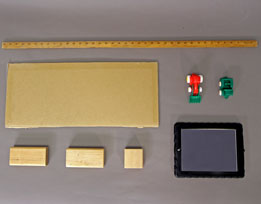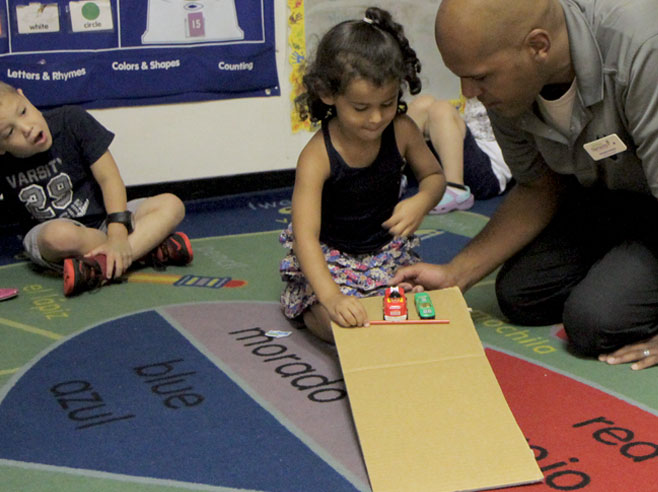The class observes how the children in this video build ramps from everyday objects and race objects down the ramps.
Materials

- Ramp Rolling video on an iPad (1 for Circle Time, several for Learning Center)
- 4–6 blocks to prop up the end of the cardboard ramps
- Camera (cell phone, iPad)
- 2 cardboard sheets (to create ramps of different steepnesses)
- Yardstick, as a starting gate
- 2 toy cars (same type, different colors)
- Row of blocks or books, as a finish line
- Optional: Projector (if available)
Preparation
- Circle Time: Introduction: If using, set up a projector to display the iPad.
- Learning Center (optional): Use the ramp race materials from Circle Time.
Directions: Lesson 5
Circle Time: Introduction
Children watch the Ramp Rolling video. Prompt children to observe the girls’ technique for using a pencil as a starting gate and a book as a finish line as they send two objects down a ramp to find out which one rolls faster.
- Explain to children that they are going to watch a video and then try an experiment.
- Introduce the video Ramp Rolling and invite children to notice the experiments the girls in the video are trying out. Possible discussion ideas:
- In this video, two girls are experimenting with balls and ramps. In one experiment, they race two balls down a ramp to find out which one is faster.
- To make the race fair, they use a pencil as a starting gate. This way they make sure both objects start the race at the same time. Let’s pay attention to what happens.
- Begin playing the video and pause after the race is done. Possible discussion ideas:
- Did the two balls roll fast or slow?
- Which ball was faster? How do you know? (It was the first to bump into the book, or finish line.)
- Watch the rest of the video to find out what other experiments the girls do with their balls and ramps. What happened to the ball when it hit the “finish” line? Replay the video if children are having difficulty recalling what happened.
- After watching the video, place two ramps (one steep and one gentle) in the center of the circle. Explain to children that you are going to set up a race so they can observe how toy cars move on two ramps with different steepnesses. Place a row of blocks or books about a foot in front of the bottom of the two ramps. Explain to children that the row of blocks/books is the finish line of the race. Take pictures of children’s races. You will discuss these during Wrap-Up time.
- Tell children that they will need to look and listen carefully to find out which car bumps into the finish line first. Make a starting gate by holding the yardstick across the two ramps. Line up the cars behind the starting line. Have children count with you—“1, 2, 3 . . . Go!”—as you release the cars at the same time from the top of the two ramps.
- Encourage children to identify which toy car hit the finish line first. Possible discussion ideas: Which ramp did this car roll down: the steep ramp or the gentle ramp? Why do you think this car won the race? Did it move fast or slow? What happened to the car after it hit the yardstick?
- You may want to repeat the race to provide more opportunities for children to observe which car moves faster down its ramp.
Another portion of this video (in which children invent a bowling game) is watched and discussed in the Ramp Rolling Revisited activity.
Circle Time: Wrap-Up
- Rewatch the Ramp Rolling video. Encourage children to closely observe what happens in the video.
- As they watch the video, pause periodically to review what is happening. Possible discussion ideas:
- How did the children make sure the race was fair?
- What do you predict will happen before this race?
- How do you know which object went faster?
- Look at the ramp race photos together. Compare how your races were the same as and different from those in the video. Possible discussion ideas:
- Did we do some of the same things in our races that the children did in the video?
- How did we make sure the race was fair?
- How did you know which object went faster?
- What happened to the cars when they hit the yardstick?
Directions: Lesson 6
Learning Center
- Invite children to rewatch the Ramp Rolling video and observe what happens closely.
- As you stop by this center, engage children in conversation. Have them describe:
- How the race was made fair
- What they predict will happen in each race
- How to tell which object went faster
- If time allows, encourage children to use the ramp materials and continue to explore racing objects down the ramps. Use similar discussion ideas as those in the Circle Time activity.


